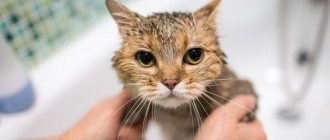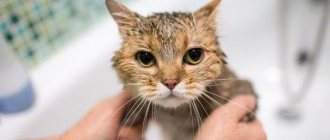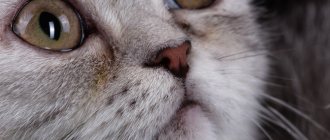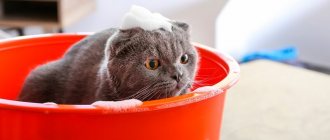To bathe a kitten or not to bathe, and if to bathe, then how? These questions become relevant when the baby is taken away from the cat and brought to a new family. Until this moment, all water procedures for the baby are performed by his mother, diligently licking her own child from the top of the head to the tip of the tail. And now it’s the turn of his new “parents”.
By this time, the kitten will be two months old; it will take some time to get used to the new home, because two stresses “for one spoon” (parting with mom and a bath day) will be too much for the baby to handle. So add about two more weeks to a couple of months - and you can take the mustachioed tabby to the bathroom.
Is it possible to bathe a kitten?
It is not only possible to bathe a kitten, but sometimes it is necessary. Because in the process of its life activity it becomes polluted, in particular, not always washing away well under the tail. In addition, oil accumulates on the coat, which leads to dullness and can also cause certain diseases. There are other reasons for giving a kitten a bath, such as skin diseases, parasites, fungi, etc. Moreover, the sooner you begin to accustom your animal to water, the easier it will be for him to accept bathing as an adult.
Article continues after advertisement
Indications for water procedures
Despite the fact that most cats take care of their own hygiene, there are times when bathing becomes a necessary measure. You should only bathe your pet if there is a real reason for this, and the pet cannot cope with it on its own:
- severe wool contamination;
- tangles and difficult-to-comb wool;
- excessive shedding;
- preparation before the exhibition;
- flea and tick treatment;
- an elderly pet does not cope with hygiene;
- as a therapeutic procedure for certain diseases.
At what age can a kitten be bathed?
Many breeders bathe cats starting from 1 month. Firstly, as we already said, it accustoms him to water. This is especially important if the animal is a show animal and will have to wash itself frequently. Secondly, this way you will take better care of your hygiene. But bathing at 1 month is the task of breeders, because it is too early to take such small kittens into a new family.
EXPERT COMMENT: KAREN BACKER, DOCTOR OF VETERINARY MEDICINE
“Some cats need baths sometimes. Greasy skin is one of the reasons why bathing may be necessary. When an overweight kitten is unable to properly groom its hindquarters, baths are often necessary for hygienic purposes. I recommend that kitten owners introduce their pets to bathing while they are young. Once a cat reaches adulthood, bath training becomes a much more complex process.”
If there is no need (the animal is clean, not for show), then bathing can begin at 3 months. The fact is that while the kitten is being cared for by its mother, she licks the baby well. But when he is separated from his mother, he does not immediately begin to wash himself properly. And while he begins to do this, his fur coat may become dirty. Then intervention will be needed.
It’s definitely worth starting to accustom your animal to water if the kitten is already 3 months old. Some wait until five, although this is already too long. At 5 months it will be more difficult to accustom the animal to the procedure.
At what age should I introduce water?
The kitten will remember the first contact with water for a long time, so you need to take the process seriously.
If your pet still has negative emotions, then next time he will fight back hard: scratching, biting and struggling with all his might. That's why you need to turn bathing not only useful, but also a pleasant pastime.
Some breeders claim that a kitten can be washed from the age of one month. This is explained by the fact that such a baby practically does not resist and does not scratch. But it’s not worth risking the baby’s psyche, because any unknown procedure is a great stress for him.
© shutterstock
Kitten's first bath
The first bath of a kitten, if it happened between the ages of 1 and 4 months, will be easy for you. But the kitten will get very stressed. To soften it, you need the following.
Bathe your cat not in a large bathtub, but in a basin, so as not to increase the panic from the huge space from which you cannot free yourself.
Talk to the animal, do not make sudden movements, perform all actions with love. Let him understand that there is nothing hostile in this process.
It is most convenient to bathe a kitten in a sink or basin, having first filled it with a little water, unlike an adult cat, which is most often bathed in the shower. It is very important not to make noise from the stream of water when bathing a small cat so that he is less afraid.
Article continues after advertisement
Watch a video on how to bathe a kitten.
Another tip on how to wash a Scottish Fold kitten and any other breed of kitten. During the bathing process, you need to lather it with a special shampoo (you can purchase shampoo for sensitive skin or special for kittens) after the fur is wet. After the cat is well soaped, the shampoo must be rinsed off thoroughly, because... otherwise, the animal will begin to lick the washed hair that has shampoo residue on it.
How to prepare for washing
From the room where you plan to wash the kitten, you need to remove everything that could frighten it. A cat’s body temperature is higher than a person’s, so the water should be no colder than +38 °C.
It is better to fill the basin with water in advance and place a jug nearby for rinsing. You should have a special shampoo at the ready; you can buy it at a pet store, selecting it according to your pet’s breed. It’s worth preparing a few soft towels, cotton pads and swabs.
A kitten's claws are no less sharp than those of an adult cat. It is advisable to cut them first.
Bathing rules are simple:
- The owner should not be afraid and feel confident. During the entire procedure, you should not be nervous or fuss. The owner's condition clearly affects the pet.
- The kitten should be held firmly with one hand, preferably by the skin in the neck area, exactly as the mother carries the baby. At the same time, you need to talk to your pet gently and calmly.
- The water in the basin should reach the baby no higher than the neck or middle of the chest. With your other hand, apply shampoo to your pet’s body and gently lather it. To wash the back of the body, it is quickly removed from the container.
- The head is washed carefully, trying to prevent water from pouring into the ears and eyes of the animal. You can skip this part of the procedure the first time.
- Having placed the kitten back in the basin, you should wash off the foam from it as quickly as possible with water from the container.
- At the end of the procedure, take the baby out of the water, grab him with your hand under the chest and quickly pour clean water from a jug over him so that it washes away the remaining foam from the body. Pour a stream onto the back of the head and back.
- The pet is quickly wrapped in a large fluffy towel. Now you need to walk around with him a little, holding him in your arms and talking affectionately.
Most of the water will be absorbed into the fabric. But you can take a few more dry towels and thoroughly rub the baby, only then allowing him to lick himself. Ears and eyes should be blotted with cotton pads.
If necessary, you can use cotton swabs to clean your ears.
If the kitten is cold, you should wrap it in a warm scarf or blanket and hold it in your arms until it warms up. Then you need to play with your pet, cheer him up and, finally, no earlier than an hour after the water procedures, offer him a treat.
Drying a kitten
After bathing, the kitten must be dried, because it will take several hours to dry. First you need to wrap it in a towel, and only then start drying it. You need to dry the kitten with a hairdryer. On the one hand, it's scary. On the other hand, the prospect of being scared is still better than the prospect of getting sick.
While drying, you need to comb the cat, wipe its eyes and ears. And at the end of the process, reward your pet with a treat so that bathing is associated with a positive ending.
Selection of hygiene products
Never wash your kitten with human shampoo, even if it is a hypoallergenic baby shampoo. Also, detergents made for puppies, dogs, ferrets and other animals are not suitable for kittens. You should also avoid using shampoos for adult cats . In babies, the mucous membranes and skin are more susceptible; they may not withstand the effects of the components of the product for adult animals.
Thus, it is important to purchase a special product for washing your kitten.
The following varieties are suitable.
Universal liquid shampoo
A reliable, convenient product that foams well. For one session you will need a very small portion. The fur of a washed animal is shiny and soft and silky to the touch.
Dry shampoo
Suitable for pets who are terrified of water. Such products have nothing to do with the bathing procedure. Spray in the form of powder is applied to dry fur, which is immediately combed out. The faded hairs remain on the comb along with the dirt.
Recommended for animals older than 3 months.
Spray
Apply to the kitten's damp fur. The advantage is that it practically does not dry out the skin, which is important for kittens under six months of age.
Special shampoo
More often offered as options for a specific breed or for animals with a specific coat type, for example, for long-haired kittens, for British breed kittens, etc.
It is recommended to choose just such an individual product, since the composition of shampoo for Sphynx and Siberian cats will vary significantly and, if replaced, will not bring the desired effect.
Special shampoos for kittens are expensive. To save on product, take small bottles, since kittens grow quite quickly, and a small bottle will be enough for your pet’s entire childhood.
Don't pass by domestic products. In terms of quality, it is in many ways not inferior to goods from foreign manufacturers, and the price is much cheaper.
Should I bathe a kitten after vaccination and castration?
After vaccination, the kitten cannot be bathed for at least 2 weeks, because during this period the animal’s immunity will be reduced by the vaccine. You should also not bathe before vaccination, so as not to reduce your immunity with stress.
After castration and sterilization, at least 10 days must pass before swimming, because... During this period, the sutures heal.
It’s also not worth bathing a kitten in the first days after you take it home. The animal is experiencing terrible stress, which you will only intensify, as a result of which its immunity will drop. The exception is yard cats, which, of course, need to be washed immediately.
Rate and share!
ATTENTION, TEST! Answer a few simple questions and find out what kind of owner you are for your cat:
Does your cat have a name?
How often do you play with your pet?
Do you get your vaccinations and parasite treatment up to date?
Is your kitten spayed/neutered?
What do you feed your purr?
What kind of owner are you for your cat?
Your kitty is very happy
Congratulations! Your purr is healthy and happy, surrounded by care and love. You are a responsible and good owner for your kitty.
Your pussy could be happier
Hmm... with such an owner, even the cockroaches will all die. Maybe you should have gotten a cactus instead of a cat? Yes, you are not the best and most caring owner, but you still have a chance to fix everything. Start taking proper care of your pet.
There is no general consensus on how many times a pet should be bathed per year. When using shampoo, recommendations for the number of times it should be used will be indicated on the packaging.











